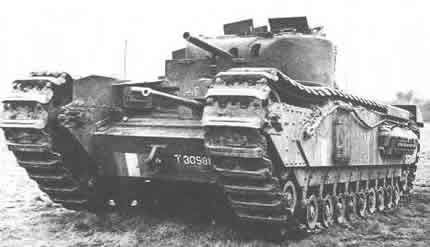 |
|
|||
|
|
||||
 |
Churchill IICS;
3" howitzer in turret, 2 pdr in hull. Few built.
Churchill III: March 1942. 6 pdr. New welded turret.
|
| Churchill IV:
Like Mk III but with cast turret. 84: 6 pdr. Early versions had Mk5 6
pdr with counterweight on end.
Churchill IV (NA75): 1st Army in North Africa fitted 120 Mk IVs with M3 75 mm and mantlets from wrecked Shermans. Used in Sicily and Italy to 1945. 84: 75 mm.
Churchill V: Like Mk IV but with 95 mm howitzer. Only 10% of Churchills had 95 mm. 47: 95 mm. Churchill VII: Existing Mk IVs converted to Mk VIIs. |
|
| British tank used in World
War II.
In 1940, after the evacuation of the British Expeditionary Force from Dunkirk, the British government commissioned the design of a new tank to replace its earlier lightweight infantry tanks. The first Churchill model, the Mark I, was ready by June 1941 and entered large-scale production soon afterward. The Mark I was armed with a 2-pounder gun in the turret and a 3-inch howitzer mounted on the hull. Like subsequent Churchill models, the Mark I had good speed and turning ability, a robust suspension system, heavy armour plating, and a low silhouette. In the Mark II model, the 3-inch howitzer on the hull was replaced by a machine gun. From the time they entered service in mid-1942, the Mark I and II tended to be outgunned by German tanks, but their ability to climb hills served them well in the closing phases of the North African campaign. Faced with the need to upgrade their tank's main armament, the British fitted the next model, the Mark III, with a 6-pounder gun. Even this gun was barely adequate by 1943, when the Mark III entered service, so later versions of this model were fitted with a 75-millimetre gun. The Mark IV closely resembled the Mark III, but its turret was welded rather than cast. The Mark IV was perhaps the most prolific Churchill tank and probably saw the most combat of any model. It was armed with either a 6-pounder or a 75-millimetre gun. The tank weighed 39 tons, had a top speed of 17 miles (27 kilometres) per hour, and had a range of 90 miles. It was served by a crew of five and mounted two 7.92-millimetre machine guns in addition to its main gun. Its successor, the Mark V, was fitted with a 95-millimetre howitzer, but the Mark VI and VII returned to the format of the 75-millimetre gun. These later Churchills were still outgunned by their German counterparts, but their thick protective armour partly compensated for the inadequacy of their firepower. Churchill tanks were employed in the Normandy Invasion in 1944 and in the ensuing Allied drive across northern France and Germany. Its well-armoured and reliable chassis made it suitable during these campaigns for a number of special-purpose adaptations. Perhaps the most fearsome was the "Crocodile," a Churchill tank in which the machine-gun was replaced by a powerful flamethrower. Other Churchills, popularly known as AVREs (Assault Vehicle Royal Engineers), were employed in assaults on fortified positions, and still others, called "carpet layers," were fitted with large rolls of steel mesh, which they laid on soft ground to provide a firm surface for other vehicles. A total of 5,640 Churchill tanks were manufactured, and some remained in service with the British army into the 1950s. Copyright © 1998-1999 Encyclopędia Britannica, Inc. |
